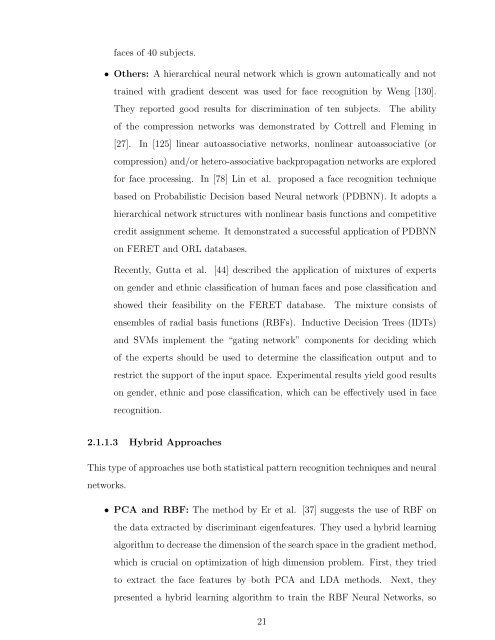Master Thesis - Department of Computer Science
Master Thesis - Department of Computer Science
Master Thesis - Department of Computer Science
Create successful ePaper yourself
Turn your PDF publications into a flip-book with our unique Google optimized e-Paper software.
faces <strong>of</strong> 40 subjects.<br />
• Others: A hierarchical neural network which is grown automatically and not<br />
trained with gradient descent was used for face recognition by Weng [130].<br />
They reported good results for discrimination <strong>of</strong> ten subjects. The ability<br />
<strong>of</strong> the compression networks was demonstrated by Cottrell and Fleming in<br />
[27]. In [125] linear autoassociative networks, nonlinear autoassociative (or<br />
compression) and/or hetero-associative backpropagation networks are explored<br />
for face processing. In [78] Lin et al. proposed a face recognition technique<br />
based on Probabilistic Decision based Neural network (PDBNN). It adopts a<br />
hierarchical network structures with nonlinear basis functions and competitive<br />
credit assignment scheme. It demonstrated a successful application <strong>of</strong> PDBNN<br />
on FERET and ORL databases.<br />
Recently, Gutta et al. [44] described the application <strong>of</strong> mixtures <strong>of</strong> experts<br />
on gender and ethnic classification <strong>of</strong> human faces and pose classification and<br />
showed their feasibility on the FERET database. The mixture consists <strong>of</strong><br />
ensembles <strong>of</strong> radial basis functions (RBFs). Inductive Decision Trees (IDTs)<br />
and SVMs implement the “gating network” components for deciding which<br />
<strong>of</strong> the experts should be used to determine the classification output and to<br />
restrict the support <strong>of</strong> the input space. Experimental results yield good results<br />
on gender, ethnic and pose classification, which can be effectively used in face<br />
recognition.<br />
2.1.1.3 Hybrid Approaches<br />
This type <strong>of</strong> approaches use both statistical pattern recognition techniques and neural<br />
networks.<br />
• PCA and RBF: The method by Er et al. [37] suggests the use <strong>of</strong> RBF on<br />
the data extracted by discriminant eigenfeatures. They used a hybrid learning<br />
algorithm to decrease the dimension <strong>of</strong> the search space in the gradient method,<br />
which is crucial on optimization <strong>of</strong> high dimension problem. First, they tried<br />
to extract the face features by both PCA and LDA methods. Next, they<br />
presented a hybrid learning algorithm to train the RBF Neural Networks, so<br />
21










